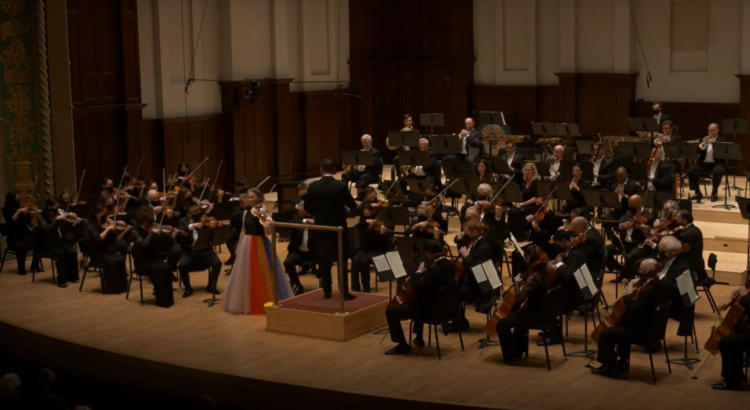Home to the fourth oldest orchestra in the United States, Orchestra Hall is truly a magnificent venue. December turned out to be the perfect time to visit, as the holiday-themed pine garlands and twinkling string lights in the lobbies paired beautifully with the red carpets and warm lighting to evoke the Christmas spirit. As a testament to Hilary Hahn’s influence and outreach work, I noticed that the audience had a notably larger proportion of younger attendees than what one would typically find at a symphony concert—including me and my four friends, of course. I found it funny when one friendly usher asked which one of us was “the violin player of the group,” and we all raised our hands.
The DSO opened the concert with Bedrich Smetana’s Overture to The Bartered Bride, a bright, vivacious piece full of moving notes and striking dynamic changes. Still groggy from the trip from Ann Arbor, I found the piece was a great opener to sit back, build excitement, and appreciate the crisp acoustics of the hall.
Next, Hilary Hahn took to the stage to perform the Dvorak Violin Concerto in A minor. Distinctly contrasting with the previous piece, the concerto featured a dramatic introduction that showcased Hahn’s virtuosity—namely some pitch-perfect runs climbing up the fingerboard and ending with her insanely powerful fourth finger vibrato. I was amazed by how clearly her sound projected over the orchestra to our seats in the balcony. The second movement took on a more somber tone, with a dark-yet-sweet melody echoed by the flutes. Meanwhile, the final movement was clean and bright, playing with a delicate, bell-like motif introduced by the soloist at its beginning. Cue the standing ovation.
Going off the program, Hahn took some time to say a few heartfelt words about the recent tragedy at Oxford High School and dedicated a solo piece she often plays alone when thinking through things. In this new context, the unaccompanied Bach Sonata for Violin Solo No. 2 in A minor, Andante adopted a whole new depth of emotion. In that hushed room packed with hundreds of people, the longing, sustained melodic line sung over an underlying current of pulses, like a heartbeat.
After intermission, the DSO performed what is probably Smetana’s well-known piece, The Moldau No. 2 from Má vlast. The piece took the audience on a journey along a great river of the same name running through Czechoslovakia, featuring flowing lines to illustrate the intermingling of hot and cold water over the natural landscape.
To conclude the concert, the orchestra played Symphony No. 3 in C minor composed by Florence Price, the first African-American woman to be recognized as a symphonic composer. Jader Bignamini, the conductor, noted the importance of playing such underrepresented works that deserve to stand amongst iconic orchestral repertoire. An exhilarating mixture of warm melodies, jazzy-ragtime rhythms, and big brassy sections, the piece was truly refreshing to listen to.
As expected, Hilary Hahn and the DSO delivered an excellent performance. I look forward to future visits to Orchestra Hall while I’m at UMich!





